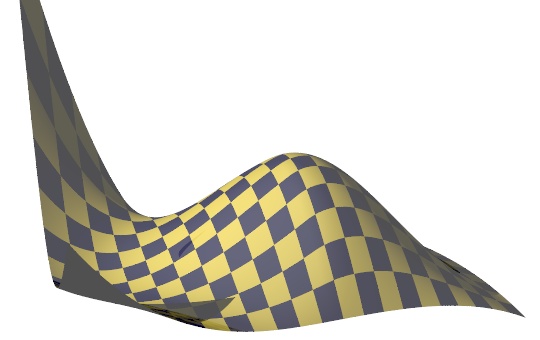Task 065: Efficient parametric surface for ray-tracing
Your task is to implement a general parametric surface as a new solid (ISolid) in our ray-tracer. The core if the assignment is to implement suitable accelerating structure for a triangle mesh, which is created using parametric surface definition.

Basis
Your solution can start with either the 048montecarlo project or the 048rtmontecarlo-script project from our repository grcis. In the latter case you will be able to define your scene using CS-script (one additional .cs file per scene).
Relevant interfaces and classes
- ISolid - general interface for R-T solids, the basic functionality is the ability to compute intersections with rays. Your new class must implement this interface.
- Sphere - an example of concrete simple solid, you can see what you will need to implement.
- Expression - arithmetic expression able to be re-evaluated many times - you can substitute actual numbers for variables (see NCalc.dll).
If you use CS-script scene definition (048rtmontecarlo-script project), you do not have to deal with expression evaluation - you will simply use function delegate and lambda-expression to define parametric surface function.
What to modify
You are supposed to work with the MonteCarloRT.cs source file. You
will create a new class public class Parametric : DefaultSceneNode, ISolid
with the required functionality.
At least one instance of your new class should be used in the scene definition
(CustomScene()).
If you will prepare more demo scenes, you have to add more scene definition functions
and to include them in a listbox (see the InitializeScenes() function).
Your scene-construction function can accept a text parameter Param: from the
form.
Your new class (surface) has to be able to define parametric functions in the constructor. Use either string symbolic expression with the help of the toolkit NCalc.dll or (in case of CS-script defined scenes) you can easily use function delegates and lambda-expression. The domain of the parametric variables u and v can be explicitly defined or fixed to <0.0,1.0>2.
If you want to define your scene using CS-script, you have to use the 048rtmontecarlo-script project, your scene-definition script will be in a separate .cs file (see the data/rtscenes/ for inspiration, scripting instructions). Scripts have access to the text paramter Param: as well.
Ideas
Decompose the parametric surface into high number of small triuangles (connected into one continuous triangle-mash). Efficient ray-mesh intersectiong algorithms: KD-tree or R-tree (BVH) or Octree. KD-tree and Octree can (usually) contain duplicate triangles, R-tree does not need duplicates. Please use the "bucket-tree" technique for higher efficiency: leaf nodes contain 1 to N triangles for some reasonable number N, e.g. 2 <= N <= 16 (it is a good idea to declare N as a parameter and study the efficiency while increasing it).
Beware: Your code must be re-entrant, it will be executed in a multi-thread environment. You are not allowed to store any temporary (intersection-specific) values in the class instance! Accelerating data structure should be built at the beginning, after this init-phase the tree must be treated as "read-only" and thus shareable.
Geometric support
There are useful support functions in the class Geometry:
RayTriangleIntersection(), RayBoxIntersection() or
RayBoxIntersectionInv(). Use them for ray intersections with triangles
or bounding boxes (AABB).
Don't forget to increment counters CSGInnerNode.countBoundingBoxes or
CSGInnerNode.countTriangles - the will show number of needed instersections
(with AABB-s or triangles).
Literature
Intermediate to advanced:
- R-tree (Wikipedia entry)
- Vlastimil Havran: Heuristic Ray Shooting Algorithms (PhD thesis)
- Ingo Wald, Vlastimil Havran: On building fast kd-Trees for Ray Tracing, and on doing that in O(N log N)
What to hand in
You must send the modified file MonteCarloRT.cs. You can include a couple of nice pictures.
In case you will be using 048rtmontecarlo-script project, you must include your scene definition[s] in separate file[s]. Script format: see the data/rtscenes/ directory in the repository.
Deadline
Hand in the assignment before: 1. 7. 2018
Points
Basis: 30 points (general parametric surface, reasonable acceleration, shading - correct normal vectors),
Bonus points: for more interesting surfaces, efficient computation, configurable 2D texture coordinates, etc.
Project
Visual Studio project: 048rtmontecarlo or 048rtmontecarlo-script
Source file
Modify and hand in the source file: MonteCarloRT.cs
Edit your name in the InitializeScenes() function!
Don't forget the .cs script if you are defining your scene using CS-script.
You can attach a couple of nice pictures in a smaller resolution.
Copyright (C) 2013-2018 J.Pelikán, last change: 2019-05-09 17:52:59 +0200 (Thu, 09 May 2019)